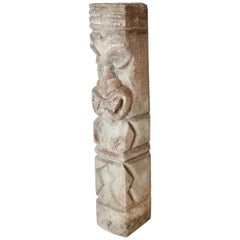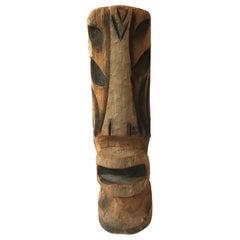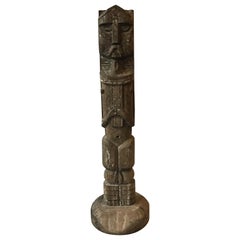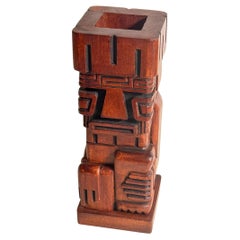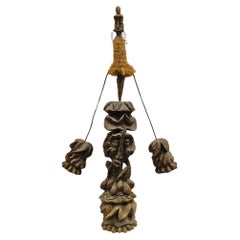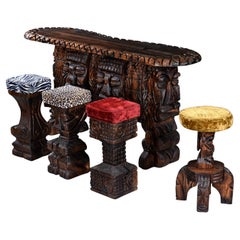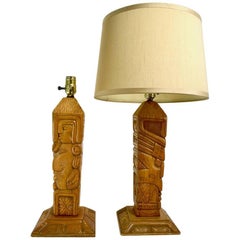Tiki Totem
Heavy cast cement Tiki totem sculpture
Located in Ferndale, MI
Cast in cement Tiki totem statue. Remnants of old paint.
Category
Mid-20th Century American Mid-Century Modern Garden Ornaments
Materials
Cement
1960s Hand Craved Wood Head Tiki Totem Sculpture
Located in Tarrytown, NY
1960s Hand Craved Wood Head Tiki Totem Sculpture
Black highlights
Carvings in the round
Category
Vintage 1960s Figurative Sculptures
Materials
Wood
1960s Carved Wood Tiki Totem Sculpture Of A Knight
Located in Tarrytown, NY
1960s Carved Wood Tiki Totem Sculpture Of A Knight
Solid Wood feels heavy - initials RJP
Bit of
Category
Vintage 1960s Figurative Sculptures
Materials
Wood
Wood Tiki Totem Sculpture Pen holder Brown Color United States 1960
Located in Auribeau sur Siagne, FR
This tiki-style carved wooden rack is unique. With its mid-century desert tiki vibe, it's the
Category
Vintage 1960s American Abstract Sculptures
Materials
Wood
$625 Sale Price
20% Off
H 11.03 in W 3.94 in D 3.94 in
Primitive Carved Wood Figural Tiki Totem Kinetic Wobbly Balancing Art Sculpture
Located in Philadelphia, PA
Vintage Primitive Carved Wood Figural Tiki Kinetic Wobbly Balancing Art Sculpture. Circa Late 20th
Category
Late 20th Century Unknown Folk Art Sculptures and Carvings
Materials
Wood
$850
H 42 in W 24 in D 7 in
Recent Sales
Mid-Century Hand Carved Witco Tiki Bar and Barstool Set by William Westenhaver
By Witco, William Westenhaver / Witco
Located in Chattanooga, TN
design. A mix of tiki totems and chess pieces that each feature their own, original bold fabric. At
Category
Vintage 1960s American Mid-Century Modern Dry Bars
Materials
Cedar
H 42.25 in W 82.5 in D 23 in
Pair of Aztec Motif Carved Wood Tiki Lamps
By William Westenhaver / Witco, Witco
Located in New York, NY
Pair of carved wood tiki, or Aztec style TOTEM lamps. Fun, funky and chic, working original
Category
Mid-20th Century American Mid-Century Modern Table Lamps
Materials
Wood
South Pacific Tiki Totem Pole Table Lamp
Located in Fulton, CA
Exotic hand carved wood table lamp made of Monkeypod wood. South Pacific origin attributed to Hawaii. Shade is new, circa 1950s-1960s. New shade.
Category
Mid-20th Century American Tribal Table Lamps
Materials
Wood
'TOTEM' OR 'TIKI' TABLE, circa 1940s
Located in Essex, MA
A carved wood "Tiki" or "Totem" occasional table, the rectangular top in black finish over a
Category
Vintage 1940s American Console Tables
Materials
Wood
1960'S American Sandwich Glass Root Beer "Tiki TOTEM" Cigar Jar
Located in West Palm Beach, FL
1960'S Americana sandwich glass root beer "Tiki TOTEM" lidded cigar jar.
Category
Mid-20th Century American Jars
Materials
Glass
People Also Browsed
Lantern Column I
By Niho Kozuru
Located in West Palm Beach, FL
Title: Lantern Column I
Year: 1998 - 2014
Medium: Mold blown glass, cast polymer, steel, cast iron
Size: 41 3/4" inches
Niho Kozuru (髙鶴丹穂) is a Japanese-born mixed media artist bas...
Category
2010s Abstract More Art
Materials
Steel, Iron
Bamboo Rattan and Wicker Weave Drum Pendant Light / Lantern
Located in Barcelona, ES
Spanish 1960s Mid-Century Modern bamboo and wicker wire pendant lamp or lantern.
This suspension lamp features a woven wicker drum shaped lampshade with triple bamboo sticks decorati...
Category
20th Century French Mid-Century Modern Chandeliers and Pendants
Materials
Bamboo, Wicker, Cane, Rattan, Paper
$2,116 Sale Price
20% Off
H 31.5 in Dm 13.39 in
Babylone Ottoman Pouf in Cashmere by Laura Gonzalez
By laura gonzalez
Located in Paris, FR
The 3-tiered Babylone pouf is made with an oak structure, high-density foam, and upholstered in velvet (LG.FB-35) with a base made of brushed brass.
Made in France.
Category
2010s French Art Deco Stools
Materials
Brass
Tulip Organic Modern Wall Sconce, Wall Light in White Plaster, Hannah Woodhouse
By Hannah Woodhouse
Located in London, GB
Handmade Tulip organic modern wall light/ wall sconce, in silky smooth white plaster, created by artist Hannah Woodhouse in her London studio. Contemporary organic modern design insp...
Category
21st Century and Contemporary British Organic Modern Wall Lights and Sco...
Materials
Plaster
$2,481 / item
H 11.8 in W 11.8 in D 7.5 in
Sasco Semi-Flush Mount Brass Light Fixture, Custom Finishes
Located in Pound Ridge, NY
The Sasco is a versatile custom-made solid brass and glass globe light fixture, which can be mounted on the ceiling or wall.
Shown here in our factory brass, an uneven unfinished br...
Category
2010s American Flush Mount
Materials
Brass
Trolley Bar Cart Handles Golf Club Mid-Century Modern Italian Design
Located in Palermo, Sicily
Trolley bar with handles golf club very funny, Italian manufacture midcentury design.
Category
Vintage 1950s Italian Mid-Century Modern Carts and Bar Carts
Materials
Metal, Brass, Chrome
$1,804
H 35.04 in W 17.72 in D 13.39 in
Early Stone Tiki Garden Statue on Base
By Tiki
Located in Ferndale, MI
Unique two piece garden statue. Tiki style form sits in stand. Most likely cast cement.
Category
Mid-20th Century American Folk Art Figurative Sculptures
Materials
Cement
Pair of Shagreen Bedside Tables by R&Y Augousti
By R & Y Augousti
Located in New York, NY
The Paris based label has distinguished themselves since their launch, with their iconic use of shagreen mixed with brass and other exotic materials. All furniture is handcrafted by ...
Category
21st Century and Contemporary Philippine Art Deco End Tables
Materials
Brass
Warren Platner Walnut and Leather Floating Case Sofa for Lehigh Leopold, c. 1970
By Warren Platner, Lehigh Leopold
Located in Los Angeles, CA
This exceptionally rare and highly sought-after collectors piece (with celebrity provenance) is a Warren Platner Executive Leather Case Sofa designed for Lehigh Leopold in circa 1970...
Category
Vintage 1970s American Modern Sofas
Materials
Chrome
$22,200 Sale Price
22% Off
H 26.5 in W 92.75 in D 32 in
'Mr Chair' and Ottoman by George Mulhauser for Plycraft, 1960s
By George Mulhauser, Plycraft
Located in Los Angeles, CA
An iconic Mid-Century Modern 'Mr. Chair' and ottoman, designed by George Mulhauser for Plycraft in the 1960s. A timeless example of American Modernist design, this sculptural lounge ...
Category
Vintage 1960s American Mid-Century Modern Lounge Chairs
Materials
Plywood, Faux Leather
$2,156 Sale Price / set
23% Off
H 32 in W 36 in D 35 in
1950s Black Bed Reading / Wall Lights Sconces 'Model 8260' By Falkenberg Sweden.
By Falkenbergs Belysning
Located in Silvolde, Gelderland
Beautiful pair tubular reading lamps / wall lights 'model 8260' in hammered black combined with brass made by Falkenberg Belysning Sweden.
These lamps can be hardwired but also used ...
Category
Vintage 1950s Swedish Mid-Century Modern Wall Lights and Sconces
Materials
Metal, Brass
$1,246 Sale Price / set
20% Off
H 3.15 in W 8.27 in D 4.73 in
Italian Retro Bar Trolley with Glass Shelves, Circa 1960s
Located in Atlanta, GA
Mid-century Italian bar trolley or vintage tv cart having a black, brass-inlaid frame with brass cross stretchers that support an upper and lower glass shelf. Raised on four casters....
Category
Vintage 1960s Italian Mid-Century Modern Carts and Bar Carts
Materials
Metal, Brass
Organic Modern White Satin Glass Globe W. Pottery Body Rustic Wall Light, 1970s
Located in Miami, FL
Rustic faux wood Mid-Century Modern pottery wall sconce from the 1960s-1970s. Very textured pottery surface resembling a piece of wood holding a satin white glass globe with one sing...
Category
Vintage 1970s American Mid-Century Modern Wall Lights and Sconces
Materials
Ceramic, Pottery, Glass
$280 Sale Price
20% Off
H 12 in W 6.5 in D 7 in
Vintage Iron And Glass Medical Cabinet, 1970s
Located in Amsterdam, Noord Holland
This medical cabinet was designed in the 1970s and was produced circa 1975 in hungary. It is made from iron and glass with glass shelves. The glass is held by a black rubber strip. T...
Category
Vintage 1970s Hungarian Industrial Vitrines
Materials
Iron
$1,443 Sale Price
20% Off
H 70.87 in W 39.38 in D 18.51 in
Taxidermy Butterfly Flying Insects Collection of Multiple Species (10)
Located in Chula Vista, CA
For your consideration, a framed glass display featuring ten (10) flying insects of different spices. Wood frame with double glass. No name or label present from the maker.
Dimensi...
Category
Vintage 1970s American American Classical Taxidermy
Materials
Glass, Wood
$240
H 12.63 in W 8.63 in D 1.75 in
12 Antique Minton England Elaborate Cobalt Jewel & Gilt Encrusted Dinner Plates
By Minton
Located in West Palm Beach, FL
An elegant set of twelve dinner or presentation plates by the fine porcelain firm of Minton's of England. Custom ordered through the prestigious retailer of William Plummer, New York...
Category
Vintage 1910s English Dinner Plates
Materials
Enamel, Gold
$5,400 / set
H 0.75 in Dm 10.25 in
Get Updated with New Arrivals
Save "Tiki Totem", and we’ll notify you when there are new listings in this category.
More Ways To Browse
Pacific Lamp
Witco Bar
Tiki Statues
Aztec Carved Table
Totem Pole Lamps
Witco Tiki Bar
Sandwich Glass Vase
Sandwich Vases
Witco Lamp
Wood Carved Tiki Lamp
Norwegian Tankard
Nude Horseback
Nymphenburg Figurine
Nymphenburg Porcelain Figurines
Oak Bedside Table With 3 Drawers
Oak Casket
Oak Church Cabinets
Oak Leaf Wrought Iron
